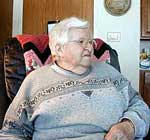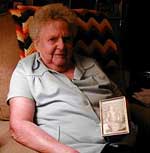
|
Solutions from Rural Minnesota
By Stephanie Hemphill, Minnesota Public Radio
March 2001
|
|
RealAudio |
By 2030, the largest age group in Minnesota is expected to be the over-65 population, but parts of rural Minnesota are there already. Small towns and rural counties struggle to provide services when fewer and fewer young people are there to take care of more and more elders. Health care workers are hard to find for low-paying personal care jobs.
| |
|
|
|
||
The Seventh Avenue Apartments in Hibbing are home to 70 residents who moved here from their homes in Hibbing and surrounding small towns and farms. They receive a hot meal every day, health services, and take part in activities, all of which would have been a lot more expensive if they were still living in homes scattered around the county.
The services are provided by Jeannie Fairbanks' employer, Fairview Range Regional Health Services. Using funds earmarked for services to people at risk of needing nursing home care, the county pays for those whose low income qualifies them for assistance; others pay on a sliding fee basis. Fairbanks says the efficiency of serving people in a central setting makes it possible to have a staff person on duty 24 hours a day.
"In this day and age, it's very rare to be able to provide that in the home. So they have the independence of having their own place, yet the availability if they need services anytime in that 24 hours to call," Fairbanks says.
Deb Romano moved in when the building opened 17 years ago. Last year she began taking advantage of the additional services when her emphysema became worse. "They help me with my shower twice a week, and do the dishes, and a homemaker cleans once a week, which I can't lean over and vacuum anymore; too short winded," says Romano
But Romano's situation is better than that facing some other older people.
Anne Johnson, 88, relaxes in her one-bedroom apartment in Kenwood. Her apartment is in an assisted-living wing at Moose Lake's Mercy Hospital. Johnson shares three meals a day with other residents in the dining room. Her apartment is cleaned once a week, and she has help with laundry. She can take part in the exercise program, outings and other activities organized for the nursing wing, also attached to the hospital.
"I just love living here," she says. "The girls taking care of us, like Annette there, I feel like she's just like my daughter. She so loving and so, well all of them."
Mercy Hospital built the assisted living wing in 1998 with nearly $1 million of its own money. There's no debt on the building, so rents can stay low.
Mercy's administrator, Diane Mandernach, says the expansion beyond hospital and nursing home service shows how small-town health organizations can help older people. "We have expanded and filled in the gaps between those two areas of service so people can feel comfortable coming here and knowing that they're going to be able to have their needs met regardless of where those needs are at," says Mandernach.
Mercy now runs a home health service, an adult day-care center, and a remodeled Alzheimer's wing. The hospital also offers a high school course on health careers, designed to encourage local young people to consider a future in the field. Mandernach calls it a "grow your own workers" program.
| |
|
|
|
||
Some career health care workers take their jobs a step further and care for elderly people in their own homes.
Terry Glapos is a registered nurse who supervises home health care for the elderly three days a week. She also shares her home with as many as five elderly women. Glapos lives on a lake, 20 miles northwest of Duluth, and all the bedrooms have lake views. Lucille Abrahamson came to live with Glapos nearly two years ago.
"My daughter looked at 15 places, they said if you don't like that place you won't like anything, that was up here, little Grand Lake. She asked if i wanted to see it, I said, 'I'll take your word for it,' and I've just loved it ever since," Glapos says.
Glapos' residence is an adult foster-care home. It's one of about 50 such homes in St. Louis County. For Abrahamson, the setting and personal care feel just right, and it's also close for her daughter to visit.
Terry Glapos says she gets a lot of satisfaction from caring for people. "In some way it's like having my grandmother back with me, my grandparents. I'm able to get a lot of positive feelings and enjoyment," she says.
The National Rural Health Resource Center's Terry Hill says such cost-effective and flexible in-home programs are the way of the future. The Duluth-based Resource Center is a clearing house that helps rural communities with health care issues. Hill says current government funding doesn't match public policy, or people's preferences.
"What we have decided is as a matter of policy is we want to keep people in their homes as long as possible. But home care has had some dramatic reductions in reimbursement, and it's particularly problematic for the rural home care programs because they have farther to travel, it's more expensive for them to provide care than it is in the urban areas," according to Hill.
But some programs capitalize on active retired people and other volunteers to help their elderly neighbors in their homes. In 17 rural communities around the state, grassroots groups use seed money of just $20,000 from the state to run 'Living at Home' block nurse programs. They deliver meals, drive elders to medical appointments, make friendly visits and telephone checks. The program is hoping to expand with more money from the Legislature.
| Part One: Sorting the Options |


